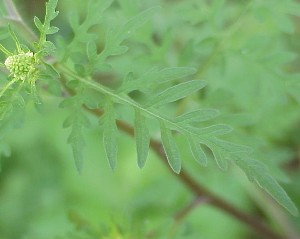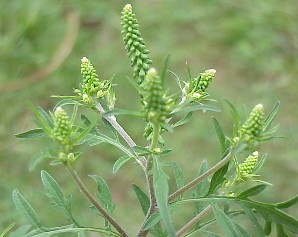Scientific name: Ambrosia artemisiifolia L.
Synonyms: Ambrosia diversifolia (Piper) Rydb.; Ambrosia elatior L; Ambrosia media Rydb.; Ambrosia monophylla (Walt.) Rydb.Common name:Annual ragweedFamily: AsteraceaeOrigin:Native of the eastern part of North America. Habit:Annual herb to 2 m tall, with an erect habit. Habitat:It is a common weed of untended areas such as old pastures, roadsides and creek banks. General description:Stems and leavesThis plant forms a basal rosette of leaves during the early stages of growth. The stems are round and reddish or brownish green in colour. They are much branched and hairless (glabrous) to roughly hairy. The leaves are oppositely arranged at the base of the plant, becoming alternate further up the stem. The leaf blades are deeply divided (pinnatifid to bipinnatifid) and up to 10 cm x 7 cm in size. Leaf stalks (petioles) are up to 10 cm long but are usually 1-3 cm in length. The uppermost leaves (ie. those near the inflorescences) are usually much reduced in size. All leaves are covered in hairs, which may be long and spreading or short and soft. Flowers and fruitsFlowers are small and cream or pale green. Separate male and female flower-heads are formed. The male flower-heads outnumber the female flower-heads. Hemispherical male heads droop from branching spike-like inflorescences borne at the tips of the stems above the female flower-heads. Female flower-heads consist of a single female 'flower' (floret). The base of the flower-head (involucre) is saucer shaped 3-5 mm long with 5-7 small spines. Flowering occurs from autumn to early winter. The fruit is a single achene, woody and top-shaped, with a awl-like beak 1-2 mm long and a ring of four to seven small spines (1 mm long). Distinguishing characteristics:Large annual herb growing upright (to 2 m tall) with fern-like leaves and distinctive inflorescences of single-sex flowers. Very similar to Parthenium hysterophorus (parthenium weed) when in the vegetative stage of growth. However, this species can be easily distinguished from Ambrosia artemisiifolia (annual ragweed) by its ribbed stems, and also by its masses of small white flower-heads when it reaches maturity. Noxious status:Declared a noxious weed in Queensland, South Australia and the Northern Territory. Its status has yet to be assessed in Western Australia, and it is therefore prohibited entry to this state until a weed risk assessment is carried out. Sources:Anonymous. Noxious Weed List for Australian States and Territories. (2000). National Weeds Strategy Executive Committee, Launceston. Kleinschmidt, H.E., Holland, A. and Simpson, P. (1996). Suburban Weeds. 3rd Edition. Department of Primary Industries, Brisbane. Parsons, W.T. and Cuthbertson, E.G. (1992). Noxious Weeds of Australia. Inkata Press, Melbourne. Stanley, T.E. and Ross, E.M. (1983-1989). Flora of South-eastern Queensland. Volume 2. Department of Primary Industries, Brisbane. |
Brisbane
St Lucia, QLD 4072
+61 7 3365 1111
© 2009 The University of Queensland


